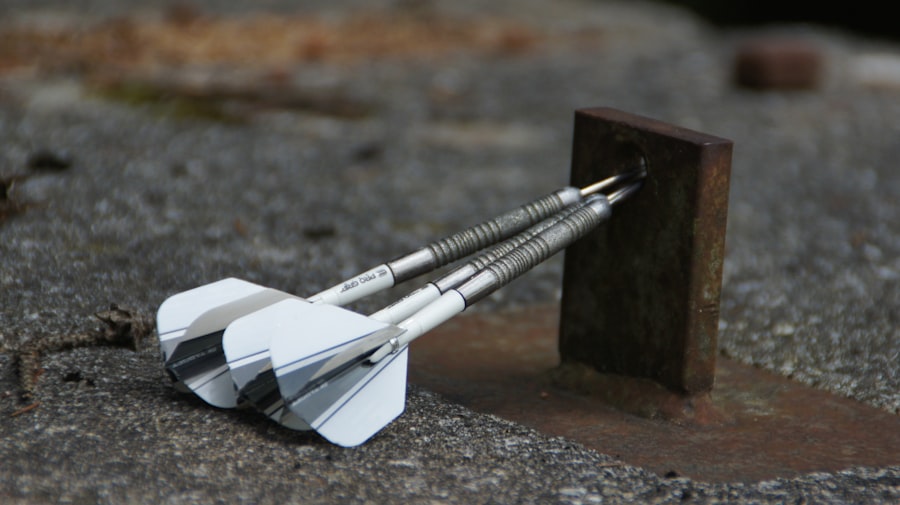Improvised weapons have been a part of human history for centuries, often emerging in situations where traditional weapons are unavailable or impractical. These tools can be anything from a simple pen to a kitchen utensil, transformed into a means of defense when the need arises. The essence of an improvised weapon lies in its adaptability; it is not the object itself that defines its potential for harm, but rather the creativity and intent of the user.
This concept is particularly relevant in self-defense scenarios, where individuals may find themselves in unexpected and dangerous situations. The effectiveness of improvised weapons often hinges on the element of surprise. An attacker may not anticipate that a seemingly innocuous object can be wielded as a weapon, giving the defender a crucial advantage.
Moreover, the psychological impact of using an improvised weapon can be significant. The defender may feel empowered by their ability to turn everyday items into tools of protection, while the aggressor may be deterred by the unexpected nature of the defense. Understanding this dynamic is essential for anyone considering the use of improvised weapons in self-defense.
Key Takeaways
- Understanding Improvised Weapons: Improvised weapons are everyday objects that can be used for self-defense in emergency situations.
- Identifying Common Everyday Objects as Weapons: Items like keys, pens, and umbrellas can be used as effective improvised weapons.
- Assessing the Environment for Potential Weapons: Look for objects in your surroundings that can be used as weapons, such as chairs, rocks, or bottles.
- Techniques for Using Improvised Weapons: Learn how to strike, block, and disarm with improvised weapons to defend yourself effectively.
- Improvised Weapons for Different Self-Defense Scenarios: Different situations may call for different improvised weapons, so be prepared to adapt to your environment.
Identifying Common Everyday Objects as Weapons
Many everyday objects possess the potential to be used as improvised weapons, often without the user even realizing it. Items such as keys, pens, and even bags can serve as effective tools for self-defense. For instance, a key can be gripped between the fingers to create a makeshift knuckle duster, while a pen can be used to jab at an assailant’s vulnerable areas.
The versatility of these objects makes them accessible to anyone, regardless of their training or experience in self-defense. In addition to small items, larger objects can also be utilized effectively. A sturdy umbrella can be wielded to block or strike an attacker, while a belt can be used to restrain or whip at an aggressor.
The key to identifying these potential weapons lies in recognizing their inherent properties—weight, shape, and durability—and envisioning how they can be employed in a defensive manner. By cultivating an awareness of their surroundings and the objects within them, individuals can enhance their ability to defend themselves using whatever is at hand.
Assessing the Environment for Potential Weapons

The environment plays a crucial role in determining what improvised weapons may be available during a self-defense situation. A thorough assessment of one’s surroundings can reveal numerous opportunities for defense that might otherwise go unnoticed. For example, in an urban setting, a defender might find themselves near construction sites where tools like hammers or screwdrivers are readily available.
In contrast, a park might offer branches or stones that could serve as effective defensive tools. Moreover, understanding the environment also involves recognizing how certain objects can be used strategically. For instance, a defender might choose to position themselves near a wall or other solid structure that can provide cover while they look for potential weapons.
Additionally, being aware of escape routes and areas with higher foot traffic can enhance one’s chances of evading an attacker while utilizing improvised weapons effectively. This situational awareness is vital for anyone looking to defend themselves in unpredictable circumstances.
Techniques for Using Improvised Weapons
| Technique | Description |
|---|---|
| Striking | Using an improvised weapon to strike an opponent, such as a heavy object or a sharp object. |
| Blocking | Using an improvised weapon to block an opponent’s attack, such as a chair or a stick. |
| Disarming | Using an improvised weapon to disarm an opponent, such as using a belt to disarm a knife-wielding attacker. |
| Throwing | Using an improvised weapon to throw at an opponent, such as a rock or a bottle. |
Using improvised weapons effectively requires not only creativity but also an understanding of basic techniques that maximize their potential. One fundamental principle is targeting vulnerable areas on an assailant’s body, such as the eyes, throat, or groin. Striking these areas can incapacitate an attacker long enough for the defender to escape or seek help.
For example, using a pen to jab at an assailant’s eye can create a momentary distraction, allowing the defender to flee.
This means ensuring that the object is held securely and used with purpose.
For instance, when wielding a bag as a shield or striking tool, it should be swung with intention rather than flailed about aimlessly. Practicing these techniques can help individuals feel more confident in their ability to use improvised weapons effectively when faced with danger.
Improvised Weapons for Different Self-Defense Scenarios
Different self-defense scenarios may call for specific types of improvised weapons and techniques. In close-quarters situations, such as being cornered in an elevator or small room, smaller objects like keys or pens may be more effective due to their ease of concealment and quick accessibility. Conversely, in more open environments where distance can be maintained, larger items like umbrellas or bags may provide both defensive and offensive capabilities.
Additionally, the nature of the threat can influence the choice of improvised weapon. For instance, if confronted by an aggressive individual who is physically imposing, using a heavier object like a rock or a sturdy stick may provide the necessary force to deter the attacker. On the other hand, if faced with multiple assailants, creating barriers with available objects or using distractions may be more effective than direct confrontation.
Understanding these nuances allows individuals to tailor their approach based on the specific circumstances they encounter.
Legal Considerations of Using Improvised Weapons

While improvised weapons can serve as effective tools for self-defense, it is essential to consider the legal implications surrounding their use. Laws regarding self-defense vary significantly by jurisdiction and can influence how individuals are permitted to respond to threats. In many places, individuals are allowed to use reasonable force to protect themselves; however, what constitutes “reasonable” can be subjective and context-dependent.
Moreover, using an improvised weapon may lead to legal consequences if it results in serious injury or death to an assailant. Individuals must be aware that even in self-defense situations, they could face criminal charges or civil lawsuits if their actions are deemed excessive or unjustified. Therefore, understanding local laws and regulations regarding self-defense is crucial for anyone considering the use of improvised weapons as part of their personal safety strategy.
Training and Practice with Improvised Weapons
Training and practice are vital components of effectively using improvised weapons for self-defense. Familiarity with various objects and how they can be employed defensively enhances an individual’s confidence and readiness in real-life situations. Engaging in regular practice allows individuals to develop muscle memory and refine their techniques, ensuring that they can react instinctively when faced with danger.
Moreover, training should encompass not only physical techniques but also mental preparedness. Individuals should practice situational awareness and decision-making skills that enable them to assess threats quickly and determine the best course of action. This holistic approach to training ensures that individuals are not only equipped with knowledge about improvised weapons but also possess the mindset necessary to utilize them effectively when needed.
Improvised Weapons for Women’s Self-Defense
Women often face unique challenges when it comes to self-defense, making improvised weapons particularly relevant in their safety strategies. Many women may feel vulnerable in various situations, whether walking alone at night or encountering aggressive individuals in public spaces. By understanding how to use everyday objects as improvised weapons, women can empower themselves and enhance their personal safety.
Common items such as hairbrushes or pepper spray can serve as effective tools for self-defense when wielded correctly. Additionally, women can benefit from training programs specifically designed for female self-defense that emphasize the use of improvised weapons and situational awareness. These programs often focus on building confidence and teaching practical techniques that cater to women’s unique experiences and challenges in self-defense scenarios.
Improvised Weapons for Children’s Self-Defense
Teaching children about self-defense and the use of improvised weapons requires a thoughtful approach that balances empowerment with safety. Children should be educated about recognizing potentially dangerous situations and understanding how everyday objects can serve as tools for protection if needed. Simple items like backpacks or water bottles can be introduced as potential defensive tools while emphasizing that these should only be used in emergencies.
Moreover, instilling confidence in children is crucial for their overall safety. Engaging them in role-playing scenarios where they practice using improvised weapons can help them feel more prepared if they ever find themselves in a threatening situation. It is essential to ensure that children understand the importance of seeking help from trusted adults and using improvised weapons only as a last resort.
Incorporating Improvised Weapons into Martial Arts Training
Martial arts training often emphasizes discipline, technique, and respect; however, incorporating improvised weapons into this training can enhance practitioners’ skills and adaptability. Many martial arts styles already include forms of weapon training; thus, integrating everyday objects into practice can provide valuable insights into creativity and resourcefulness during self-defense situations. By practicing with improvised weapons alongside traditional martial arts techniques, practitioners can develop a deeper understanding of timing, distance management, and situational awareness.
This combination not only broadens their skill set but also prepares them for real-world scenarios where they may need to think outside the box when defending themselves.
Self-Defense Strategies for Vulnerable Populations
Vulnerable populations—such as the elderly, individuals with disabilities, or those living in high-crime areas—may face unique challenges regarding personal safety and self-defense. Developing tailored strategies that incorporate improvised weapons can empower these individuals while addressing their specific needs and concerns. For instance, elderly individuals may benefit from lightweight objects that are easy to handle but still effective for defense, such as walking sticks or umbrellas.
Similarly, individuals with disabilities might focus on using items within reach that require minimal physical exertion but still provide a means of protection. By fostering awareness and providing practical training on using everyday objects defensively, communities can help vulnerable populations feel safer and more confident in their ability to protect themselves when necessary. In conclusion, understanding improvised weapons encompasses various aspects—from identifying everyday objects that can serve as tools for defense to recognizing legal considerations surrounding their use.
By assessing environments for potential weapons and practicing techniques for employing them effectively, individuals can enhance their personal safety strategies across different scenarios. Whether focusing on women’s self-defense or addressing the needs of vulnerable populations, incorporating improvised weapons into training programs fosters empowerment and preparedness in an unpredictable world.
In the ever-evolving landscape of modern conflict, the ability to adapt to improvised weapons has become a crucial skill for military personnel and security forces. This topic is explored in depth in an article on In The War Room, where experts discuss strategies and training methods to effectively counter unconventional threats. The article highlights the importance of flexibility and innovation in developing countermeasures against improvised devices, emphasizing the need for continuous learning and adaptation in the face of unpredictable challenges. For a more detailed exploration of these strategies, you can visit the related article on their website.
FAQs
What are improvised weapons?
Improvised weapons are objects that are not designed for use as weapons, but can be used as such in a self-defense situation. These can include everyday items such as keys, pens, or even a rolled-up magazine.
How can someone adapt to using improvised weapons for self-defense?
Adapting to using improvised weapons for self-defense involves being aware of your surroundings and identifying potential objects that can be used as weapons. It also requires training and practice to effectively use these items in a self-defense situation.
What are the advantages of using improvised weapons for self-defense?
Improvised weapons can provide individuals with a means of self-defense in situations where traditional weapons are not available. They can also be used discreetly and can catch an attacker off guard.
What are some common improvised weapons that can be used for self-defense?
Common improvised weapons for self-defense include keys, pens, umbrellas, belts, and even everyday items such as a smartphone or a laptop bag.
Are there any legal considerations when using improvised weapons for self-defense?
It is important to be aware of the legal implications of using improvised weapons for self-defense, as laws regarding self-defense can vary by location. It is advisable to seek legal advice and understand the laws in your area regarding the use of force for self-defense.




